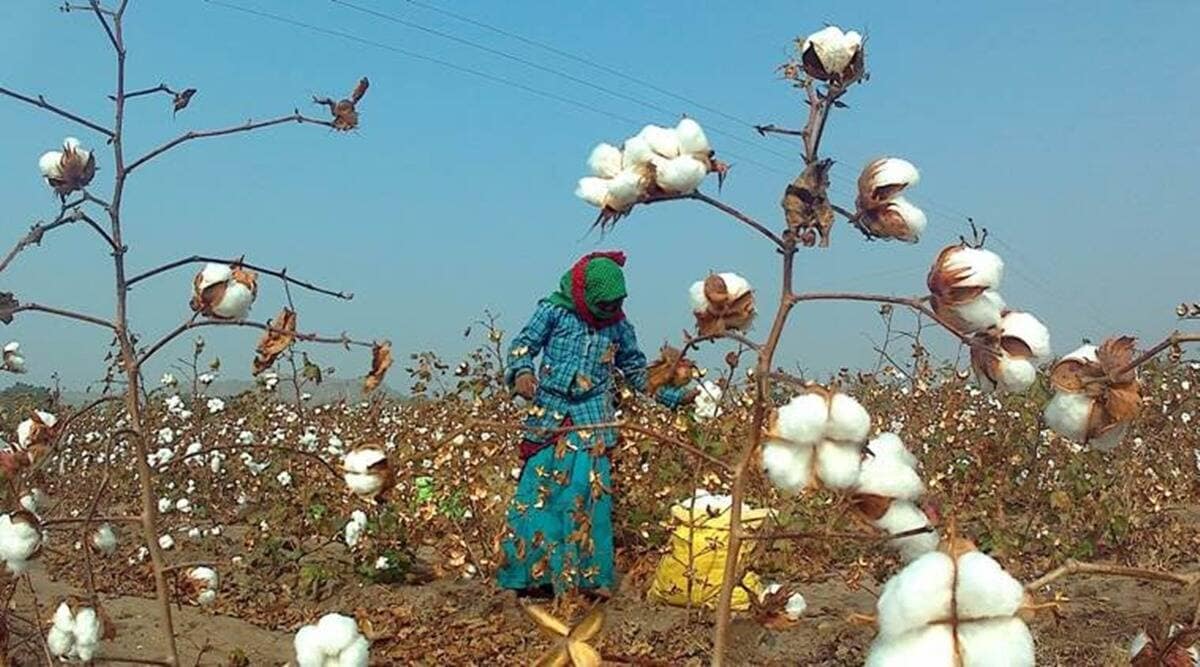 Cotton plantation was done on 42 lakh hectare compared to 39.36 lakh hectare last year. (File)
Cotton plantation was done on 42 lakh hectare compared to 39.36 lakh hectare last year. (File) Till the end of August, the total area covered under kharif crops in Maharashtra stands at 145.95 lakh hectare. The kharif sowing this year has shown marginal increase by 2.02 lakh hectare in comparison to last year for the same period when it was 143.93 lakh hectare, said officials on Saturday.
Despite incessant rain and floods in some parts of Maharashtra, the sowing of kharif crops has not been affected. But what has set the 1.52 crore farmers of the state worried is the quality and quantity of harvest.
The primary report from the agriculture department puts crop damage due to rain and floods across ten lakh hectare. The criteria adopted for evaluation of damage and compensation assessment is rainfall beyond 65 mm within 24 hours and 33 per cent crop loss.
The data sourced from the department shows an average kharif crop sowing between 2016-2017 and 2020-21 is at 153.88 lakh hectare.
A highly placed source in the agriculture department said, “Although our estimate was higher sowing, the reason for a shortfall was erratic climate conditions. There was intense rain especially in Eastern Vidarbha, parts of Marathwada, North and Western Maharashtra. The coastal Konkan belt was subjected to at least two major cyclones followed by floods.”
An officer in the agriculture department said, “The coverage gives satisfaction. But only after harvest will we be able to ascertain how much the production has been hit.”
The sowing of the main kharif crop, soyabean, has shown moderate increase. Soyabean was sowed on 45 lakh hectare against 41 lakh hectare a year ago. Majority of the farmers from Vidarbha and Marathwada depend on soyabean cultivation.
Another cash crop, which is the mainstay of farmers in the backward Vidarbha and Marathwada regions is cotton. Cotton plantation was done on 42 lakh hectare compared to 39.36 lakh hectare last year.
The area under oilseeds sowing stands at 50.62 lakh hectare, higher than previous years of 48.23 lakh hectare, the data showed. Since 2014, the Maharashtra government along with the Centre has been urging farmers to grow oilseeds. It is also a part of the central scheme which is promoting oilseeds cultivation to meet domestic requirements of edible oil so that it can curtail imports to a great extent.
Sugarcane plantation is mostly done during winters (rabi season) but some farmers took to sugarcane cultivation on 3.69 lakh hectare, showing higher coverage from last year’s 2.47 lakh hectare for the identical months.
If we exclude sugarcane plantation, the kharif sowing till August end 2022 drops from 145.95 lakh hectare to 142.26 lakh hectare. Whereas, last year’s kharif sowing area minus sugarcane stood at 141.45 lakh hectare.
The regionwise analysis excluding sugarcane sowing for kharif crops is as follows: Konkan: 4.1 lakh hectare, Nashik: 20.39 lakh hectare, Pune: 11.66 lakh hectare, Kolhapur: 7.34 lakh hectare, Aurangabad: 20.42 lakh hectare, Latur: 27.64 lakh hectare, Amravati 31.3 lakh hectare and Nagpur 19.37 lakh hectare.
With IMD indicating early withdrawal of monsoon, the overall area under kharif sowing is unlikely to alter as it began early July. Due to the rains, the farmers had to go for second and third sowings between July and August end. At least 40 per cent farmers have been adversely affected by the heavy rains.
Farmer leader and Swabhimani Shetkari Sanghatana president Raju Shetti said, “The rains have wrecked lives of the farmers. Across the state, the rains and floods have badly impacted farming.” Shetti believes 78 per cent small and marginal farmers who depend on the kharif season for a livelihood will be pushed into a severe financial crisis this year. “The agriculture sector will require a lot of assistance from both centre and state,” he cautioned.
In the recently-concluded monsoon session in the state legislative Assembly, Chief Minister Eknath Shinde and Deputy Chief Minister Devendra Fadnavis reassured all help to the farmers to override the crisis. The CM announced Rs 13,600 per hectare compensation for crop loss. The compensation was increased from the previous Rs 6,800 per hectare sanctioned under the National Disaster Relief Fund.
State agriculture minister Abdul Sattar said, “The state government is sensitive towards farmers’ problems. The government will do everything possible to help farmers reeling under the crisis.”